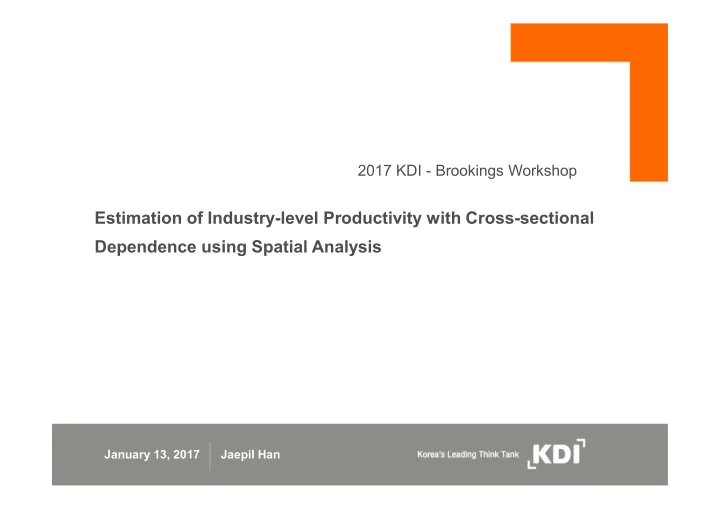

INSIDabcdef_:MS_0001MS_0001 INSIDabcdef_:MS_0001MS_0001 2017 KDI - Brookings Workshop Estimation of Industry-level Productivity with Cross-sectional Dependence using Spatial Analysis January 13, 2017 Jaepil Han
INSIDabcdef_:MS_0001MS_0001 INSIDabcdef_:MS_0001MS_0001 1. Motivation 2. Methodology 3. Spatial Weights Matrix 4. An Empirical Application 5. Conclusion
INSIDabcdef_:MS_0001MS_0001 INSIDabcdef_:MS_0001MS_0001 Motivation Intersectoral network Fig 1. Intersectoral network corresponding to the U.S. input-output matrix in 1997 Source: Acemoglu et al., 2012 How can we measure industry-level productivity considering interconnectivity among industries?
INSIDabcdef_:MS_0001MS_0001 INSIDabcdef_:MS_0001MS_0001 Methodology Measuring Productivity Non-econometric approach - Growth accounting, Index-number approach - Jorgenson and Griliches(1967), Diewert(1976) - Strong assumptions: Constant returns to scale, Perfect competition etc. - No considerations on the interdependence Econometric approach - Advantages: Free of the restrictive assumption, Flexibility of models - Disadvantages: Possible insufficient information, complication of flexible models - Typically, error terms are assumed to be symmetric.
INSIDabcdef_:MS_0001MS_0001 INSIDabcdef_:MS_0001MS_0001 Methodology Stochastic Frontier Analysis Fig 2. Frontier function vs. Production function Output Best-practice = + − production function Inefficiency Average production function Input I follow Cornwell, Schmidt, and Sickles (1990).
INSIDabcdef_:MS_0001MS_0001 INSIDabcdef_:MS_0001MS_0001 Methodology A Spatial Econometric Model Cross-sectional dependence - Possible presence of common shocks - Spatial dependence - Idiosyncratic pairwise dependence (with no particular pattern of common components or spatial dependence) Ignoring CSD causes inefficient, sometimes inconsistent, estimation.
INSIDabcdef_:MS_0001MS_0001 INSIDabcdef_:MS_0001MS_0001 Methodology SAR and SDM General Nesting Spatial Model (Elhorst, 2014) = + + + , = + SARCSS = ⨂ + + + + + SDMCSS = ⨂ + + ⨂ + + + +
INSIDabcdef_:MS_0001MS_0001 INSIDabcdef_:MS_0001MS_0001 Methodology Marginal Effects in Spatial Models (1)
INSIDabcdef_:MS_0001MS_0001 INSIDabcdef_:MS_0001MS_0001 Methodology Marginal Effects in Spatial Models (2) SAR SDM
INSIDabcdef_:MS_0001MS_0001 INSIDabcdef_:MS_0001MS_0001 Spatial Weights Matrix Economic Distance (1) Backward and Forward Linkages Fig 3. Hypothetical supply flows of intermediate inputs + + = 0 = +
INSIDabcdef_:MS_0001MS_0001 INSIDabcdef_:MS_0001MS_0001 Spatial Weights Matrix Economic Distance (2) Multiplier Product Matrix (Sonis, Hewings, and Guo; 1997) = ∙ , = ∑ = ∑ where . Take Euclidean norm to make MPM symmetric: = + = Economic Distance between industry i and j − ≡ max
INSIDabcdef_:MS_0001MS_0001 INSIDabcdef_:MS_0001MS_0001 Spatial Weights Matrix Weights Exponential Distance Decay Function (Brunsdon et al. 1996) (−η = exp )
INSIDabcdef_:MS_0001MS_0001 INSIDabcdef_:MS_0001MS_0001 An Empirical Application Data Data (1) World KLEMS Database - Quality-adjusted variables - Period: 1947 - 2010 - 31 industries (NACE) (1) World Input-Output Database - Period: 1995 - 2011 - little variation across time, so averaged over time - 31 industries (NACE)
INSIDabcdef_:MS_0001MS_0001 INSIDabcdef_:MS_0001MS_0001 An Empirical Application Industry Classification
INSIDabcdef_:MS_0001MS_0001 INSIDabcdef_:MS_0001MS_0001 An Empirical Application Parameter Estimates
INSIDabcdef_:MS_0001MS_0001 INSIDabcdef_:MS_0001MS_0001 An Empirical Application Direct, Indirect, and Total Elasticity
INSIDabcdef_:MS_0001MS_0001 INSIDabcdef_:MS_0001MS_0001 An Empirical Application Efficiency Scores (1)
INSIDabcdef_:MS_0001MS_0001 INSIDabcdef_:MS_0001MS_0001 An Empirical Application Efficiency Scores (2) The least efficient industry: Electrical and Optical Equipment (Ind8) The most efficient industry: Construction (Ind12)
INSIDabcdef_:MS_0001MS_0001 INSIDabcdef_:MS_0001MS_0001 Concluding remarks This paper proposes a method for choosing an appropriate weights matrix when there is no particular pattern of dependence. A unified measure characterizing the linkage between a pair of industries is constructed. The total output elasticities of factor inputs are estimated larger than the estimated elasticities from non-spatial specification. The U.S. economy has increasing returns to scale for the last six decades when only spatially weighted dependent variable is included in the model. However, the returns to scale is not significantly increasing if we additionally assume that the factor inputs also show cross-sectional dependence.
Recommend
More recommend